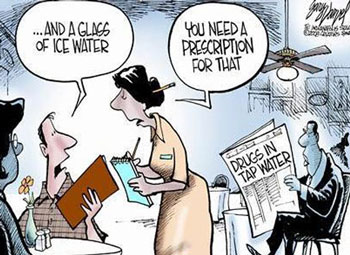New report shows alarming traces of prescription drugs, chemicals and other contaminants in Lake Michigan and how pharmaceutical drugs are showing up in fish and drinking water
In a joint report by the International Joint Commission, the scientists in both countries US and Canada have discovered alarming traces of prescription drugs, caffeine, chemicals and other contaminants in Lake Michigan.
According to the report, only half of prescription drugs and contaminants are removed from the sewage waste after the treatment since the personals at the sewage treatment do not have more advanced equipments to effectively remove all the contamination.
The commission report states that the impact of most of these "chemicals of emerging concern" on the health of people and aquatic life remains unclear but better water treatment at the Great lakes is required.

Antonette Arvai, the physical scientist at the International Joint Commission and the leading author of the study says that "the compounds show up in low levels parts per billion or parts per trillion - but aquatic life and humans aren't exposed to just one at a time, but a whole mix. We need to find which of these chemicals might hurt us".
The study suggests that more than 1,400 wastewater treatment plants from both US and Canada discharge 4.8 billion gallons of treated effluent into the Great Lakes every single day. The scientists looked into 10 years of data from wastewater treatment plants worldwide to learn how effectively the 42 compounds (that are increasingly showing up in the Green Lakes) have been removed.
What they found was that acetaminophen, estriol (a natural estrogen) and caffeine had high removal rates but the wastewater plants had low removal rates for 11 of the 42 chemicals. According to the researchers, "the weight of evidence suggests that at least half of the 42 substances examined in the present study are likely to be removed in municipal wastewater treatment plants".
Alarming levels of untreated chemicals and drugs found in the Great Lakes:
Two anti-inflammatory drugs: According to the chemistry professor and researcher at the University of Buffalo who studies emerging chemicals in the Great Lakes, Diana Aga, the anti-inflammatory drug diclofenac bioaccumulates in fish, but its impact is unclear. However, with different side effects of pharmaceutical drugs, one would wonder what would be the long-term health consequences of a drug like diclofenac? In fact, previous research have linked other drugs in fish to anxiety, altered eating habits and slower reaction times to predators.
Two antibiotic drugs and an antibacterial drug: Triclosan is an antifungal and antibacterial compound found in consumer products such as soaps and toothpastes which has been proven to be toxic to algae and disrupt hormones in fish. The report found out that wastewater treatment plants had "medium efficiency" removing Triclosan from the Lakes.
The chemistry professor, Dr Diana Aga is worried how the alarming levels of antibiotics would affect people's health. "Even at low levels you don't want to have people ingest antibiotics regularly because it will promote resistance" she says.
An herbicide: Herbicides have been known to destroy the beneficial algae and plants and in fact, the active ingredient in Monsanto's best selling herbicide "Roundup" (known as "Glyphosate" linked to infertility, cancer and organ failure) is now showing up in the urine of cows and the drinking water. Although the US Environmental Protection Agency requires that the level of glyphosate in drinking water not to exceed 0.7 ppm, the reports show that the US water levels have 7,000 more glyphosate than the amount allowed for animal organ damage. http://www.seattleorganicrestaurants.com/vegan-whole-food/toxicity-GMO-corn.php
Anti-seizure drugs: With severe side effects of pharmaceutical drugs, one would wonder how accumulation of anti-seizure drugs would affect people's health.
 Does this mean that the chemicals showing up in the wastewater will be found in drinking water?
Does this mean that the chemicals showing up in the wastewater will be found in drinking water?
Although, the chemicals showing up in the wastewater might not necessarily end up in your drinking water, the studies have found prescription drugs in drinking water at parts-per-trillion levels. In fact, a federal study of 74 waterways used for drinking water in 25 different states showes that 53 waterways had one or more traces of pharmaceutical drugs.
Although 12 pharmaceuticals are currently on EPA's list of chemicals under consideration for drinking water standards, there are no deferral regulations or limitations for presence of pharmaceuticals in waste or drinking water.
Although some researchers believe that large lakes would dilute pharmaceutical drugs much quicker, a recent study suggests that the prescription drugs are contaminating Lake Michigan two miles from Milwaukee's sewage outfalls. The leading author of the study, Rebecca Klaper (the associate professor at the University of Wisconsin-Milwaukee) says that "the ability of the drugs to travel and remain at relatively high concentrations means that fish and other aquatic life are exposed, so there could be "some serious near-shore impacts".
Michael Murray, the scientist with the National Wildlife Federation's Great Lakes Regional Center who is on the IJC's boar says that it's important to not place blame squarely on wastewater treatment plants. They weren't designed to handle these types of chemicals. And most municipalities in the Great Lakes are under tight budgets and they're just doing what they can to meet requirements.
In fact, according to Allison Fore, the spokesperson for the Metropolitan Water Reclamation District of Greater Chicago Most plants use activated sludge treatment, which uses bacteria to break down solids that come in from the wastewater. Since the chemicals come into the plants at such low levels, many of them readily break down. Therefore, other newer technologies, such as ozonation or carbon filters are more effective at removing pharmaceuticals and other new chemicals but they are expensive.
While our drinking water is turned into a cocktail of chemicals and drugs of giant chemical and pharmaceutical companies, the executives of these companies live in their gated communities and with private golf courses:
From oil companies spilling billions of gallons of oil into our oceans, to giant pharmaceutical companies marketing medications with severe side effects, to giant chemical and biotech companies poisoning everything that we eat, our inhabitant and the lives of millions of other species on this planet are being terrorized and threatened by a handful of corporations who would never take responsibility of their actions ever.

In fact, the giant pharmaceutical companies spend a lot more money on promoting and selling their drugs rather than research and studies. Thanks to giant pharmaceutical companies, these days we have all kinds of mind altering drugs for common problems (like depression or anxiety) that everyone faces at some point in their lifetime. As a matter of fact, antidepressants are one of the most commonly prescribed medications in the US and about 250 million prescriptions are filled every single year.
Anxiety is now a clinical illness and more than 12% of teenagers aged 12 or above are taking antidepressants that all have mood altering side effects like suicide thoughts. These days, millions of children below ten years old are diagnosed with all kinds of mental disorders and just like tobacco companies, the giant pharmaceutical companies know that if they get kids hooked on their drugs when they're young enough, they have them as a customer for life.
The genius marketing ideas of the pharmaceutical companies is the fact that they invent all kinds of chronic disorders ranging from sleeping disorders, dry eye syndrome to social phobia and they encourage the public to pop pills like a candy for the diseases that they created at the first place.
The reason we do not know the potential dangers of pharmaceutical drugs until it's too late (like when a drug starts killing people) is because the pharmaceutical industry systematically hides this information from the public. Even when a drug is banned for having severe side effects, the giant Pharma find ways to release the same drug under a different name into the market.
Giant Pharmaceutical and chemical companies are spinning out of control. They manufacture and sell diseases and FDA refuses to go after these people that are poisoning our air, water and food supply.
In fact, recent studies suggest that common anti-anxiety medications (which ends up in wastewater after it's been excreted from patients via urine) significantly changes fish behavior and makes them more aggressive. According to researchers, the pharmaceuticals like Prozac, (which are frequently showing up in U.S. streams), can change genes responsible for developing fish brains and controlling their behavior.
Amazingly, a while ago I watched a program on how elephants in Africa are going crazy by showing aggressive behaviors like raping rhinoceroses, killing people, attacking one another and stampeding without provocation. These intelligent and sensitive giant beings have become very, very disturbed. The researchers believe that the cause is overwhelming, unrelenting trauma and stress.
In the wild, the elephants are so protective of their babies and their herd. But while in captivity, their behavior radically changes. Recently a mother elephant in a zoo stepped on her own baby and tried to kill him. Thanks to the vigilent zoo keeper, the baby elephant was quickly rescued. (Source: Baby elephant in China can't stop crying after being stomped by mom)
Many might wonder why do these animals are behaving so strangely, but the facts are that we are shooting them in front of their families, squeezing them into smaller lands and destroying their habitats while poisoning their foods and drinking water. These are profound and irreversible changes to everything they know about their world and everything about what it means to be an elephant.
Elephants are no longer elephants, Fish are no longer fish and People are no longer people
The reason many people can no longer get off psychiatric medications is because the withdrawal effects are sometimes ten times worse than their current side effects. Here is how it works:
Despite a medication's severe side effects, the med is released into the market as 'safe, because a doctor was paid by the drug manufacturer and giant pharmaceuticals to publish an article that the drug is supposedly 'safe. The doctor makes money, the giant pharmaceuticals make money, the government makes money, FDA gets paid for approving the drug and they are all in on it, drinking from the same kool-aid.
Sources:
http://www.environmentalhealthnews.org/ehs/news/2013/drugs-in-lake-michigan
http://www.huffingtonpost.com/2013/09/27/great-lakes_n_4003110.html#slide=2958519
http://www.nature.com/news/anti-anxiety-drug-found-in-rivers-makes-fish-more-aggressive-1.12434
http://www.scientificamerican.com/article.cfm?id=fish-on-prozac-prove-anxious-anti-social-agressive


